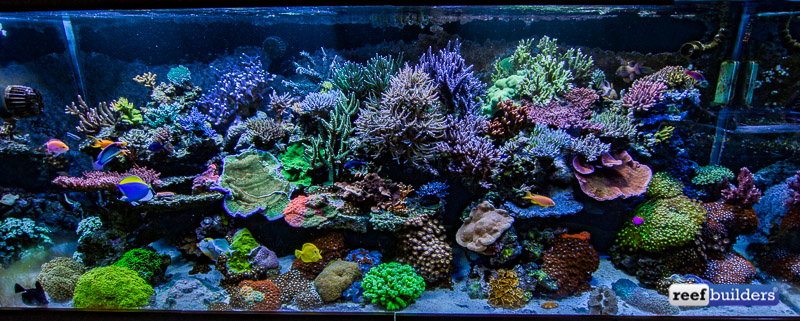With the reefing hobby’s increasing emphasis on frags and collecting corals rather than growing them, it’s becoming increasingly rare to see what a real grown out mini reef aquarium should look like. Thankfully, our old friend Cris Capp of Aquatic Art Inc. hasn’t lost sight of what the reef hobby is all about, and he shows off his mad reefing skills in a huge and coral packed aquarium at his store in Highlands Ranch, Colorado.
Aquatic Art Inc. is located in a commercial building unit, not in a busy crowded shopping mall and you’d be forgiven for thinking you are in the wrong place when you pull up to the outside of the metal building. However, the moment you walk through the doors visitors are given an instant attitude adjustment with dozens of perfectly lit reef tanks housing several thousand corals.

But the first to grab your attention literally right when you walk in is a huge, mature reef tank that is packed wall to wall not with frags, but large and mature colonies of many different types of corals. The top half of the Aquatic Art reef tank is dominated by SPS corals, mostly Acropora, but there’s plenty of diversity throughout the tank.
On the bottom half of the tank are diverse stands of LPS corals, notably a trio of brilliantly colored Euphyllia corals. Many of the once frag-sized zoanthids and chalice coral frags have all but taken over their local real estate, making for scant room on the bottom of the reef tank. One notable specimen in this reef tank is a highlighter yellow-green colony of Goniopora which has been growing in the local area for over 15 years, and Capp keeps his colony pretty large despite being one of the favorite grazing snacks of the powder blue tang.

One of the things that makes this tank really work is an exquisite aquascape, both of the rock layout and of the placement and growth forms of the mature coral colonies. There is no rock-wall syndrome here, with a diversity of colors and shapes which work well together from top to bottom, side to side and front to back.
Despite being a relatively new aquarium at about three years old, one remarkable feature of this tank is the notable lack of LED lighting. Cris started the tank with a battery of Aqua Illumination SOL LEDs and while the color was decent, the growth rate, especially of the stony corals, left much to be desired. To this end the tank lighting was gradually switched back to contemporary metal halide lighting and the resulting stony coral growth and density of corals is undeniable.

The rest of the reef aquarium equipment is simple yet effective; Vortech MP60s at either end, a couple MP40s on the back and eductor-powered return lines provide plenty of flow in this nine foot long reef tank, while still being rather unobtrusive. All the filtration for the roughly 600 gallon volume is underneath the tank, and since there wasn’t room for one huge skimmer, a pair of large Reef Octopus needle wheel skimmers were buddied up in the sump.
On the mineral balance side, this tank uses both a calcium reactor and a kalkwasser reactor to get the most automated replenishment of calcium and carbonates, and the high pH of the kalkwasser balances out the low pH of the CO2 from the calcium reactor. Other than that, a media reactor cycles through carbon and GFO on a regular basis and a generous dosing regimen of AcroPower keeps the corals supplied with an appropriate amount of beneficial amino acids.

One piece of equipment we were surprised to see managing the tank is a Digital Aquatics Reefkeeper aquarium controller. A decade ago it may have seemed silly to have so much equipment running uncontrolled but since so much of our dumb aquarium equipment are becoming smart connected devices, there is less and less need to have one central controller, and one crucial single point of failure to carry the whole tank.
Instead, Cris uses the Reefkeeper as a glorified light timer, pH and ORP monitor, and the calcium reactor has its own dedicated Milwaukee instruments pH controller. This simplified approach to reef keeping, using tried and tested technologies is really a big part of the success of this massive reef tank.

By keeping simple and not getting sucked into how much technology can be packed into the reef tank, Cris is better able to pay attention to the more important requirements of healthy, fast-growing corals. With such a dense population of corals in this aquarium volume, the colonies make huge demands for calcium, alkalinity and trace elements.
Also the corals are already at the point where constant pruning is required to keep any one coral from taking over. We’d all rather be grooming corals and enjoying the tank than trying to figure out to use fussy aquarium gear to do tasks which should be simple. Aquarium displays like this reef tank at Aquatic Art Inc. reminds us of the importance of having a reef tank that is beautiful to look at, regardless of the trade name of a given coral or what bleeding edge reef gear is running it.















